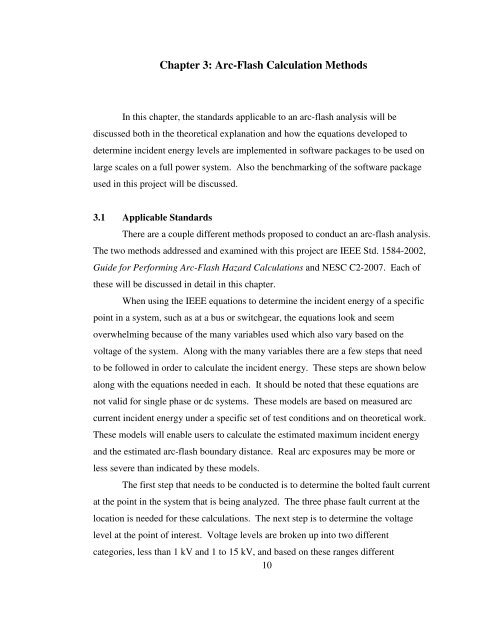arc-flash analysis of utility power systems - Michigan Technological ...
arc-flash analysis of utility power systems - Michigan Technological ...
arc-flash analysis of utility power systems - Michigan Technological ...
You also want an ePaper? Increase the reach of your titles
YUMPU automatically turns print PDFs into web optimized ePapers that Google loves.
Chapter 3: Arc-Flash Calculation Methods<br />
In this chapter, the standards applicable to an <strong>arc</strong>-<strong>flash</strong> <strong>analysis</strong> will be<br />
discussed both in the theoretical explanation and how the equations developed to<br />
determine incident energy levels are implemented in s<strong>of</strong>tware packages to be used on<br />
large scales on a full <strong>power</strong> system. Also the benchmarking <strong>of</strong> the s<strong>of</strong>tware package<br />
used in this project will be discussed.<br />
3.1 Applicable Standards<br />
There are a couple different methods proposed to conduct an <strong>arc</strong>-<strong>flash</strong> <strong>analysis</strong>.<br />
The two methods addressed and examined with this project are IEEE Std. 1584-2002,<br />
Guide for Performing Arc-Flash Hazard Calculations and NESC C2-2007. Each <strong>of</strong><br />
these will be discussed in detail in this chapter.<br />
When using the IEEE equations to determine the incident energy <strong>of</strong> a specific<br />
point in a system, such as at a bus or switchgear, the equations look and seem<br />
overwhelming because <strong>of</strong> the many variables used which also vary based on the<br />
voltage <strong>of</strong> the system. Along with the many variables there are a few steps that need<br />
to be followed in order to calculate the incident energy. These steps are shown below<br />
along with the equations needed in each. It should be noted that these equations are<br />
not valid for single phase or dc <strong>systems</strong>. These models are based on measured <strong>arc</strong><br />
current incident energy under a specific set <strong>of</strong> test conditions and on theoretical work.<br />
These models will enable users to calculate the estimated maximum incident energy<br />
and the estimated <strong>arc</strong>-<strong>flash</strong> boundary distance. Real <strong>arc</strong> exposures may be more or<br />
less severe than indicated by these models.<br />
The first step that needs to be conducted is to determine the bolted fault current<br />
at the point in the system that is being analyzed. The three phase fault current at the<br />
location is needed for these calculations. The next step is to determine the voltage<br />
level at the point <strong>of</strong> interest. Voltage levels are broken up into two different<br />
categories, less than 1 kV and 1 to 15 kV, and based on these ranges different<br />
10
















